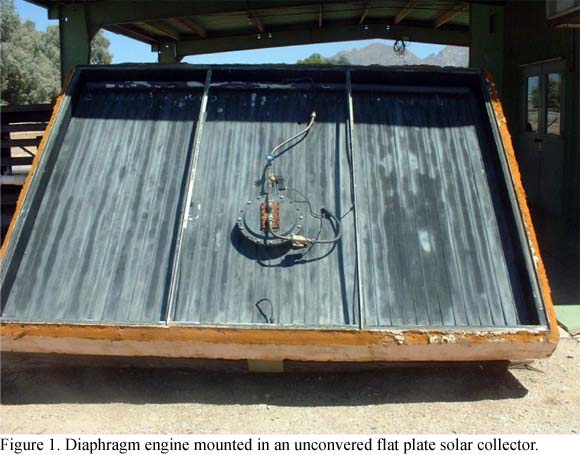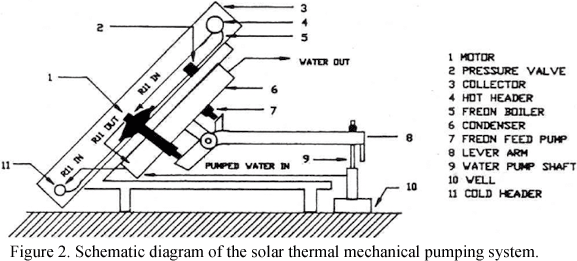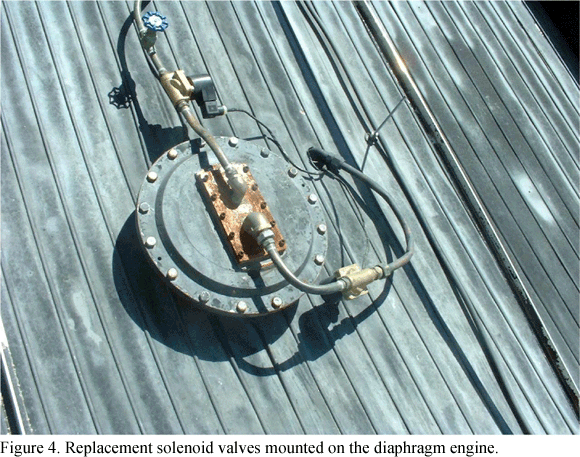An. 4. Enc. Energ. Meio Rural 2002
Development of a small solar thermal mechanical pumping system
Dennis L. Larson; Salim Al Rawahy
University of Arizona, USA
ABSTRACT
The University of Arizona is developing a <1kW sized solar thermal mechanical pumping system that appears to have great potential for meeting small pumping requirements (~4000 liters/day with 10 m lift) in locations with adequate solar resource. This solar pumping system is believed to be applicable to many remote domestic and irrigation applications without access to electricity, relying on diesel power and/or having insufficient wind for pumping and to be a cost competitive, locally manufacturable alternative to photovoltaics. The system consists of solar collector, single piston diaphragm engine, custom valving, condenser and return pump. The piston actuates a lever connected to a lift pump. Testing in Oman is scheduled for Spring, 2003.
INTRODUCTION
Attempts to convert solar energy to useful mechanical energy date back at least to the independent development of engines using thermal expansion of air and of steam engines by Ericsson and Mouchot in the 1860's (Kemper,1977). These developments were followed by ebbs in interest after the introduction of internal combustion engines and inexpensive fuels, then by reawakened activity when fuel supplies were limited.
The latest surge in solar thermal engine development followed the 1974 oil market turmoil, activity which again declined as oil became relatively inexpensive in the 1980's. Spencer (1989a,b,c) presents a rather comprehensive summary of the development of solar powered engines smaller than 100kW. Many of the engines advanced only to proof-of-concept stage, while others were commercialized. However, none continued to evolve and be improved in a manner similar to the internal combustion engine, improvements which incorporated new materials and computerized controls.
Thermal engines are often classified by thermodynamic cycle (Rankine, Stirling, Brayton), physical configuration (piston, vane, turbine) and working medium (gas, steam), but classification by temperature range may provide better correspondence with solar collector type (low temperature for solar ponds and flat plate collectors, medium temperature, perhaps 100-300C, for parabolic trough collectors, and high temperature with parabolic dish collectors) (Tabor, 1962). Higher temperature solar collector output permits more efficient thermal to mechanical energy conversion, but also requires greater solar energy concentration and tracking of the sun, ranging from no tracking with flat plate collectors to single axis tracking with parabolic troughs to two dimensional tracking with parabolic dishes. Only Rankine cycle engines may be considered with low to medium temperature inputs.
A number of small (1-25 kW) piston, vane and turbine engines were developed in the 1970's and 1980's, mostly by independent inventors or researchers (Halcrow, 1983). Examples of development by large firms or governmental agencies include a multi-vane expander by General Electric (Eckard, 1975), a 10 kW turbine with Freon as working fluid in Austria (Austria, 1981) and small (<1 kW) piston engine and larger (~25 kW) turbine by the French firm SOFRETES (Spencer, 1989b). All of these units were coupled to solar flat plate collectors. Many of the systems were developed specifically for pumping (Pytlinski, 1978).
University of Arizona researchers evaluated a ~1 kW single piston, diaphragm engine mechanically connected to a reciprocating water pump and powered by a solar flat plate collector two decades ago, Figure 1 (Larson, Sands & Dutt, 1979). System efficiency was about 1 % and mechanical failures eventually interrupted testing. A later project redesigned the diaphragm engine valving system, partially resolving the mechanical problems (Larson & Huaut-Elias, 1989). The redesign and development of this system to prototype stage is the subject of this paper.

OBJECTIVES
To develop a solar thermal powered pumping system to prototype stage.
To evaluate the performance of the solar pumping system.
To analyze the economic feasibility of the solar pumping system.
To develop commercial interest in production of the solar pumping system.
JUSTIFICATION
Today, electric motors powered by solar photovoltaic (PV) cells are used to drive pumps, refrigerators and other mechanical devices in applications around the world. Many of these applications require battery storage of energy for use on demand and conversion of electric power from DC to AC to interface with user equipment. PV systems are expensive, manufactured in only a few places in the world and usually repaired by component replacement. Reliable, cost effective solar thermal power systems might more effectively and appropriately meet many remote mechanical power demands. These systems could be manufactured in the user's country and repaired by a local mechanic.
The University of Arizona has been evaluating and improving the design of a <1kW sized solar thermal pumping system which appears to have great potential for meeting small pumping requirements (~4000 liters/day with 10 m lift) in locations with adequate solar resource. This solar pumping system is believed to be applicable to many remote domestic and irrigation applications in Oman without access to electricity or relying on diesel power for pumping. The system consists of a single piston diaphragm engine, custom made valves, condenser and return pump. The piston actuates a lever connected to a lift pump; the working fluid is an organic fluid commonly used as a refrigerant, Freon11, Figure 2.

Initial evaluation quantified pumping capability, but revealed mechanical or operational reliability problems. One of the principal problems was early failure of the valves and the difficulty of repairing the valves (the engine had to be removed from the collector and taken apart to work on the valves), Figure 3. A new valve design (Figure 4) may have resolved valving problems, but requires refinement. Three other development issues also must be addressed: assurance of proper start-up on a cold morning, removal of engine from solar collector to permit use of commercial collectors and replacement of Freon11 with a non-ozone threatening fluid. The University of Arizona investigator directing past research has agreed to collaborate on this proposed development project.


PROCEDURES
- A prototype solar powered pumping system will be designed and constructed using the Arizona solar flat plate collector-diaphragm piston engine model as the starting point. Design improvements will consider utilization of a commercially available solar collector and valving components, valve and engine maintenance, installation of a cold weather start-up controller, substitution of a current refrigerant for Freon11 and other commercialization issues.
- The solar powered pumping system will be tested to determine energy conversion and pumping performance and evaluate operation, maintenance and reliability of the system.
- Solar system capital cost and operating expenses, lifetime and pumping capability will be projected and compared with diesel powered and PV powered alternatives.
- Results of the project will be documented and commercialization pursued with assistance of the University development offices.
EXPECTED OUTCOMES AND THEIR SIGNIFICANCE
It is expected that this project will produce a design for a prototype solar thermal powered pumping systems suitable for commercialization and will provide performance and cost data which will promote its commercial use. The system is believed cost competitive with solar PV and could be manufactured in developing countries and repaired locally, and thus be a future source of local employment.
This solar powered pumping system will provide a possible means for mechanized pumping of water in areas lacking power and a more economical, environmentally acceptable substitute for diesel powered pumping, yielding benefits to many in remote locations needing water for domestic and irrigation requirements.
REFERENCES
Austria (Federal Press Service). 1981. The Austrian 10kW solar power plant for developing countries. Final report. Austrian Federal Press Service, Ministry for Science & Research, Vienna.
Eckard, S.E. 1975. Multivane expander as prime mover in low temperature solar or waste heat application. Paper, 10th IECEC, Univ of Delaware, Newark.
Halcrow, Sir William and Intermediate Technology Power Ltd. 1983. Small-scale solar powered pumping systems: technology, economics and advancement. The World Bank, 1818 H St, Washington, D.C. 20585.
Kemper, J.S. 1977. Pictorial history of solar energy use. Sunworld 5:17-32.
Larson, D.L., C.D. Sands II and G.R. Dutt. 1979. Solar and wind powered pumping with water harvesting. Paper 792574, Winter ASAE Mtg., New Orleans, LA.
Larson, D.L. and J. Huaut-Elias. 1989. Solar powered water pump development. Paper 89110 presented 1989 Pacific Region ASAE Mtg, Sacramento, CA.
Pytlinski, J.T. 1978. Solar energy installations for pumping irrigation water. Solar Energy 21(4):255-262.
Spencer, L.C. 1989 a,b,c. A comprehensive review of small solar powered heat engines: Part I. A history of solar powered devices up to 1950. Solar Energy 43(4)191-196. Part II. Research since 1950- "conventional" engines up to 100kW. Solar Energy 43(4):197-210. Part III. Research since 1950- "unconventional" engines up to 100kW. Solar Energy 43(4):211-225.
Tabor, H. 1962. Use of solar energy for production of mechanical power and electricity by means of piston engines and turbines. Solar Energy 6(3):89-93.











 How to cite this paper
How to cite this paper